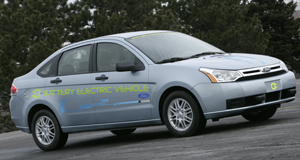
At the dawn of the automotive age, engineering decisions were made that ultimately shaped the industry, and today’s auto makers face similar deliberations in determining the future of electric vehicles.
While most car makers are choosing advanced lithium-ion batteries to power their early EVs, the question of how to heat or cool the delicate packs has OEMs veering off in different directions.
Tesla Motors Inc., one of the first companies to offer a roadworthy electric car, has opted for a liquid-based thermo-management system, able to monitor each cell separately and heat or cool it appropriately.
Tesla CEO Elon Musk tells Earth2Tech.com air-cooling batteries is a recipe for disaster, warning such a system would produce temperatures “all over the place” and cause “huge degradation” in battery performance.
Ford Motor Co., following its own internal evaluations, agree Musk is on to something and is opting to go with more-efficient, albeit pricier, liquid-cooling systems for its upcoming EVs, including an electric version of the Focus C-car and Transit Connect small utility van.
“(Batteries) operate the best at the same temps that humans like,” Sherif Marakby, Ford’s chief engineer-global core HEV propulsion system engineering, tells Ward’s. “Very hot or very cold (temperatures) suck performance of a battery.”
Ford’s system, much like Tesla’s, keeps the battery pack at a steady temperature and also is able to precondition the battery for optimum performance upon startup.

On hot days, chilled water absorbs heat from the batteries, dispersing it through the radiator before pumping it through the chiller again.
On cold days, heated water warms the batteries, gradually bringing the system’s temperature to a level that allows it to efficiently accept charge energy and provide enough discharge power for expected vehicle performance.
“We run the cooling (system) across every single cell. Whether its in the middle or outside the pack, all are individually monitored and cooled appropriately,” Marakby says, noting the Focus’ Li-ion pack has some 400 individual cells.
The thermo-management system also aids longevity, inspiring Ford to rate the battery pack for 10 years or 150,000 miles (241,000 km).
“Active liquid systems are more effective than air systems at regulating lithium-ion battery temperature,” he says. “As a result, the active liquid system on (the) Focus electric will play a key role in providing our customers with the best performance possible.”
Nissan Motor Co. Ltd. is taking a different route. Its upcoming Leaf small electric car utilizes air cooling for its Li-ion pack, a strategy the auto maker considers tried-and-true, citing “18 years of research and development” of pack design and chemistry.

“Our pack design itself, not only the chemistry, but the architecture of the pack itself, is designed to work at all the ambient temperatures found in the U.S,” Mark Perry, Nissan North America Inc. director-product planning and advanced technology, tells Ward’s.
“If we were in Dubai and launching this car, you’d have to do some additional cooling,” he says.
Nissan never seriously considered liquid-cooling, Perry says, suggesting liquid-cooling is overkill. He also notes the Leaf’s flat battery packs offer more surface area, which is better for heat management.
Additionally, in a statement emailed to Ward’s, Nissan claims its cell structure offers “superior cooling performance to the more common cylindrical cell design” offered by competitors.
Nissan doesn’t clarify the competitors to which it refers, but both Ford and General Motors Co. in its upcoming Chevrolet Volt extended-range electric vehicle use a prismatic Li-ion cell design about the size of a greeting card.
“I don’t know if air-cooled was ever considered,” GM spokesman Brian Corbett tells Ward’s. “Given the size of the battery, (liquid cooled) was just the right decision to make.
“We have 288 cells in the battery and to individually cool and heat each of them enables the Volt to perform in extreme climates,” he adds, noting, like Nissan, the Volt’s pack will have an 8-year, 100,000-mile (161,000-km) warranty.
Nissan remains confident its air-cooled system will work, as well as keep costs down on the Leaf that will sticker at $32,780. Ford has yet to announce pricing for its Focus and Transit EVs, but GM says the Volt will retail at $41,000. All EVs will quality for a $7,500 federal tax credit.
When asked about Nissan’s strategy, Ford’s Markaby is diplomatic. “You’ll probably see different philosophies out there,” he says. “But we want to make sure we can maintain the performance of the car and don’t want to expose the battery to extreme temperatures for very long because it affects its life.”
Tesla’s Musk is more cutting in his remarks.
“Tesla’s battery has a more-sophisticated/complicated cooling system than the air-cooled system found in the Leaf pack, but Nissan strongly supports its battery pack with an 8-year, 100,000-mile warranty and has been working on lithium-ion battery technology for a long time,” he tells Earth2Tech.
“We imagine they know what they're doing, and the proof will be in driveways soon enough.”



